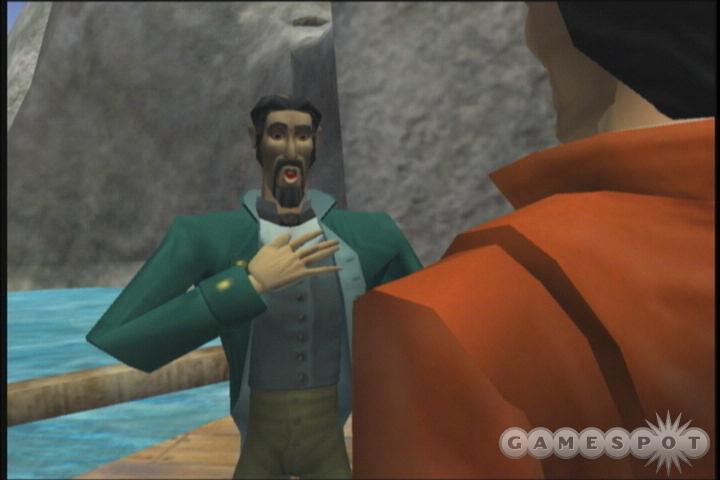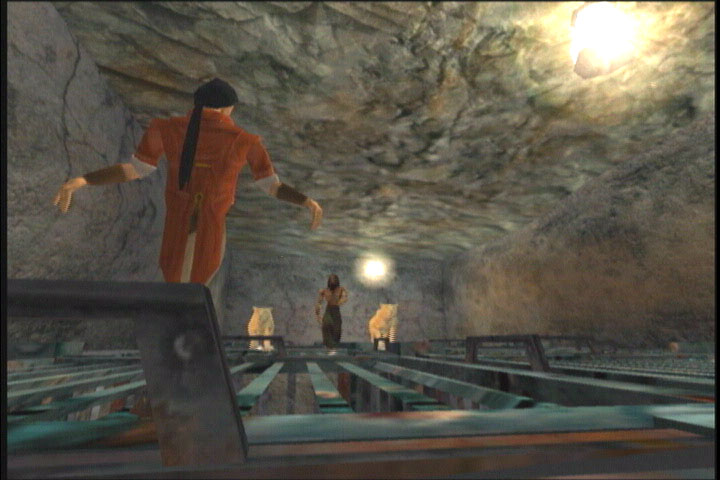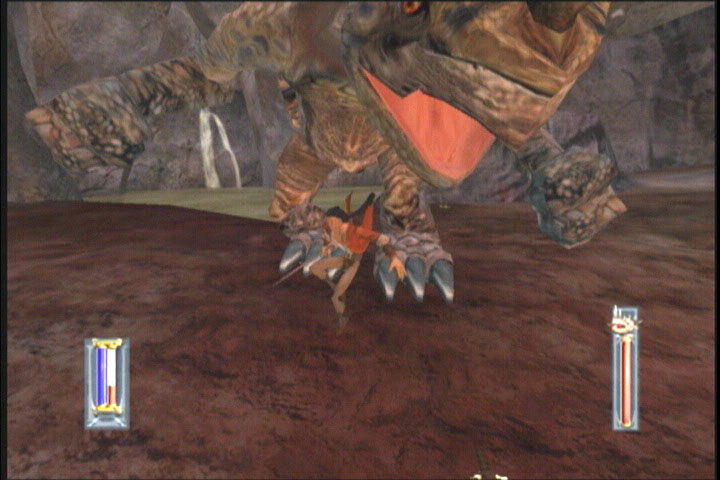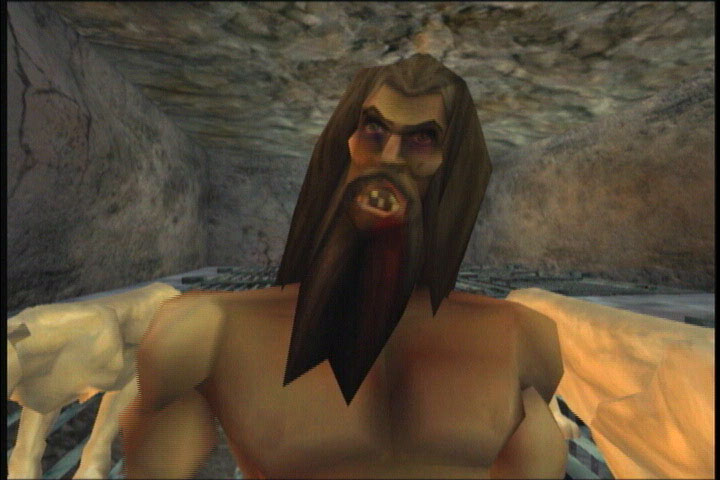Galleon: Islands of Mystery was originally announced for the Sega Dreamcast way back in 1999. Developed by the original designers of the first Tomb Raider game, Galleon eventually moved to the PS2, then the GameCube, and finally settled as an Xbox-exclusive title during the long course of its development. More than five years after work first started on the game, Galleon is finally here. The ideas and concepts found in Galleon are extremely ambitious--but also deeply flawed mechanically. This is an action adventure game that absolutely permeates with potential, but Galleon just didn't come together as a fully cohesive or entertaining experience.

Galleon's strongest aspect--its story--is perhaps its least inventive. You play as Captain Rhama Sabrier, a dashing, daring, dandy sea captain who commands his own boat and crew. At the beginning of the game, Rhama is contacted by a world-famous healer named Areliano. It seems that a strange boat has floated ashore on the island where Areliano resides, and on it was a strange herb that was thought to be long extinct. This herb contains amazing healing properties if used correctly and it has extremely dangerous power if used incorrectly. Areliano wants Rhama to help him discover the origin of this mysterious ghost ship, but when the good captain arrives on the scene, betrayal enters the picture and soon thereafter Rhama and Faith (Areliano's daughter) are sent on a quest to stop evildoers from misusing this magical herb.
While Galleon's story itself isn't especially remarkable, what makes it work is the game's colorful array of characters whose interactions with one another are both believable and wholly entertaining. Rhama's character is voiced with brilliant flare, with just enough arrogance to sell the character, but not enough to make him unlikable. The supporting cast is made up of similarly excellent voice acting, as well as some very well-written dialogue that keeps the story moving and keeps you interested in where it will take you. Furthermore, the situations the game puts you in, while crazy and convoluted, all make a certain amount of sense within the context of the story and the gameworld--a feat that can often be rare in games of this type.
So exactly what type of game is Galleon? Essentially, it's what would happen if you took Tomb Raider, threw it into a blender with more platforming elements, strained out much of the combat, added in a dash of role-playing, and hit "puree." Galleon is really all over the map in terms of gameplay types, but that's partly where it gets its charm.
A big part of Galleon's challenge comes from just trying to make use of Rhama's many abilities. Rhama is quite likely the most nimble human being ever to walk the earth without the benefit of superhuman powers. He can jump great distances if you build up a good amount of running speed; he can scale walls with the greatest of ease; and he also can't be turned without moving the camera. Wait, what? Yes, that's right: Galleon's camera controls are married to the left thumbstick, the same stick you use to move Rhama around. What this means is that when you turn the camera one way or the other, Rhama will instinctively move right along with it (meanwhile, most third-person-perspective games conventionally allow you to adjust the camera independent of the character's movement). While this may seem horribly counterintuitive, it actually isn't as bad as it sounds. It only really becomes a problem when you're trying to climb walls or navigate a tight space, at which point even the most subtle movements of the stick will cause the camera to react wildly, which can be annoying or frustrating.

Rhama's jumping mechanics are also a little on the crazy side. Specifically, the split-second timing of a jump is absolutely crucial, but not in a good way. You have to press the stick forward at exactly the right moment after performing a jump in order to attain the proper distance. Otherwise, you'll fall flat. This is especially painstaking when you're trying to navigate one of the game's jump puzzles, of which there are quite a lot. Another issue with this is that Rhama will simply interact with anything he comes in contact with. If you get too close to a wall or a pole, or really any object that might come between you and a jump, Rhama will instinctively start to slide down it or try to grab onto it, or anything of that sort. While it's neat that Rhama does more than simply slide past objects like this, the context-sensitive actions, as you can imagine, become supremely frustrating after a while, as they keep happening when you don't want them to. It's possible to get a handle on the controls--but expect a fair amount of trial and error early on along with a whole lot of missed jumps.
Galleon does have its combat elements, but there really isn't much to them at all. Rhama has some basic hand-to-hand moves, as well as the ability to engage in swordplay. As you encounter enemies, you'll be able to string together some basic attack combos by simply hitting the X button. As you perform more attacks, you'll earn combo points, which can be parlayed into more powerful attacks that will appear on the screen. By pressing the button combination that appears, you can wipe out more enemies at once as well as simply do more damage. It's a cool idea for a system, but the actual execution of it is sloppy. It's hard to ever really feel like you're in control of Rhama, as many of his attacks seem like they just kind of fling him in a random direction. Meanwhile, enemy artificial intelligence is downright bad, as foes tend to simply run around in weird groupings, only attacking if you get too close. Bosses are a bit better, but not all of them. Though some of the bosses are quite large, all you ever need to do is find a way to hop on their backs, climb up their necks, and stab them in their head a few times. The smaller bosses actually tend to be more challenging, but not much.

Galleon also contains something of an RPG-style party system element to it. As you play, you'll have a few characters that will team up with you during certain sections. The characters themselves are AI-controlled, but you can command them to do things by using the right analog stick. Essentially, all of the in-game menus, such as your usable items, available weapons, and available characters can be accessed by tapping the right thumbstick to the right, then by moving up and down to select the category, tapping right again, and moving up and down again to select the proper item or character. Once you have a character selected, you can instruct him or her to use certain items, such as doors or ladders, or you can actually have that character perform a special ability. Faith, for example, has the power to heal you or anyone else in your party. While this is all good in theory, the interface for this setup is just clunky, especially if you're in a combat situation. Trying to sort through this right stick-oriented menu screen while evil pirates are surrounding you just isn't conducive to creating a positive effect.
Perhaps the most ambitious aspect of Galleon is its level design. There are seven "proper" levels in the game and most of the main levels are absolutely huge and riddled with tons of puzzles. These levels contain platforms from which you can jump to and fro and really, really cool set designs. One example in particular is the game's effective second level, where you arrive on the island of a famed shipwright named Calverly. This island is immense, both in height and in breadth. Much of the work here involves simply trying to get to the top of the island, which houses the elusive Calverly's home, while simultaneously navigating a ton of puzzles and jumps in order to get there. The puzzles in Galleon are not always especially enthralling, but they're rarely unchallenging. At times they do border on tedium, but at the very least, they keep you guessing. As for the set design, there's a lot of creative stuff to be found in every level, ranging from the design of basic set pieces to the actual aesthetic look. As you explore, you can't help but find yourself marveling at the scope of it all.
However, aesthetic design is really about the only thing Galleon has going for itself graphically. As this game was originally conceived ages ago, it's not hard to understand why Galleon looks equally ancient from a technology standpoint. The character models are quite archaic, though you can kind of forgive that due to the endearing nature of the characters themselves. You can almost say the same for the environments, as the sheer size of them can often make you forget the poor quality of the textures. The key word is almost, though, as you will keep noticing the generally low-res look of the game as you play. Also, despite the fact that Confounding Factor has been working on this game for five years now, it's still glitchy. Issues with Rhama falling through floors or getting stuck in certain objects or animations are infrequent, but persistent, and as mentioned before, the camera is definitely not above bugging out. The game animates very smoothly, though the frame rate will get bogged down here and there when too many things are going on at once.

Galleon's audio component is truly great, however, even apart from the stellar voice acting we mentioned previously. Notwithstanding a few glitched or generally off-kilter effects here and there, nearly all of the sound effects are excellent and they really add a nice level of flare to what's happening onscreen. Galleon also boasts a well-produced soundtrack, which, unfortunately, can be a little abrupt in certain transitions; however, the music itself is quite good and it adds to the atmosphere of the game.
When all is said and done, Galleon: Islands of Mystery fails to live up to its incredibly lofty aspirations, but it does so in spectacular fashion. Everything the game brings to the table--the way Rhama handles and his many abilities, as well as the challenging puzzles and huge level environments--are brilliant in concept. Unfortunately, after five years of development time, it seems as though no amount of tweaking could quite make Galleon into the game the developers had originally envisioned. In fact, at times you can actually picture the people working on this game finally just collectively throwing their hands up in utter prostration and simply saying to hell with it all. Yet, regardless of the game's mechanical failures, if you're a fan of games that fall into the genres that Galleon attempts to dabble in, it is worth playing just to experience what it tries to do. It's probably not worth a purchase, but it's a solid rental that will show you some very cool ideas.